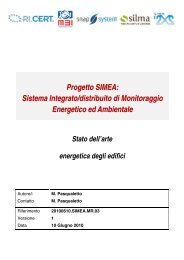Progetto SIMEA - Automatica - Università degli Studi di Padova
Progetto SIMEA - Automatica - Università degli Studi di Padova
Progetto SIMEA - Automatica - Università degli Studi di Padova
You also want an ePaper? Increase the reach of your titles
YUMPU automatically turns print PDFs into web optimized ePapers that Google loves.
<strong>SIMEA</strong> Stato dell’arte energetica <strong>degli</strong> e<strong>di</strong>fici<br />
1.2.6. BEAVER<br />
16<br />
Doc.No 20100610.<strong>SIMEA</strong>.MR.03<br />
Versione 1<br />
WINDOWS environment for the ESPII Fortran program which<br />
estimates the energy consumption of buil<strong>di</strong>ngs using the ASHRAE Response<br />
Factor Method. BEAVER buil<strong>di</strong>ng energy simulation provides for user<br />
friendly input of data, processing and viewing of the results.<br />
BEAVER estimates the energy consumption of a buil<strong>di</strong>ng hourly over a<br />
given period of time taking into account the site location, the buil<strong>di</strong>ng<br />
structure and the type of buil<strong>di</strong>ng services installed to maintain the desired<br />
environmental con<strong>di</strong>tions. It enables a designer to investigate alternatives and<br />
make energy comparisons quickly and effectively for a very wide range of buil<strong>di</strong>ng configurations and air<br />
con<strong>di</strong>tioning systems using actual measured climatic data.<br />
A comprehensive range of air handling systems, primary plant and control strategies enable the<br />
modelling of a wide range of buil<strong>di</strong>ng services SYSTEMS. Numerous plant items can be in<strong>di</strong>vidually<br />
scheduled so that fans, coils, thermostats, outside air cycles, chillers, boilers, heat exchangers, energy<br />
recor<strong>di</strong>ng meters can all have their own operating times. The program can be used in Southern and Northern<br />
latitudes.<br />
1.2.6.1. Validation/Testing<br />
The program has been BESTESTed.<br />
1.2.6.2. Expertise Required<br />
Knowledge of air con<strong>di</strong>tioning systems and thermal heat transfer is essential. A one day training<br />
course is recommended.<br />
1.2.6.3. Users<br />
41 companies in Australia and New Zealand.<br />
1.2.6.4. Au<strong>di</strong>ence<br />
HVAC design engineers and contractors, local government and university teaching departments.<br />
1.2.6.5. Input<br />
The geometric details of the buil<strong>di</strong>ng inclu<strong>di</strong>ng sha<strong>di</strong>ng schemes and the internal people, lights and<br />
equipment loads. Load profiles and operating schedules.<br />
Details of the each air handling plant and the zones/rooms they serve. The Air Handling system type is<br />
selected from a series of graphics which <strong>di</strong>splay the details included with the unit. To this basic system<br />
various extra components or operating strategies can be added inclu<strong>di</strong>ng Heat Recovery, Preheat Coils,<br />
Exhaust Fan, Temperature reset on heating and cooling coils, etc. The primary plants which can include<br />
boilers, chillers, on site generators, waste heat boilers, solar collectors, ice or chilled water storage tanks.<br />
These components can be linked in numerous configurations with a wide range of control schemes. Part load<br />
performance is user specified with provision for adjustment on the basis of outdoor air dry or wet bulb<br />
temperature.<br />
Data input is interactive (mouse driven) via WINDOWS <strong>di</strong>alogue boxes, selection lists drop down lists<br />
and entry fields on a series of screens running through general Project information to in<strong>di</strong>vidual space data<br />
and for all the buil<strong>di</strong>ng services plant, capacities, operating schedules, etc. Buttons on the toolbar and special<br />
keys allow the user to copy in<strong>di</strong>vidual values, columns of data or complete screens from space to space or<br />
system to system and there is a facility for making global changes.
















